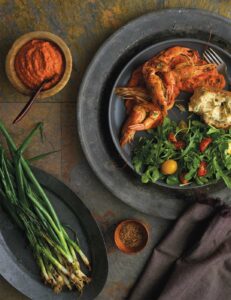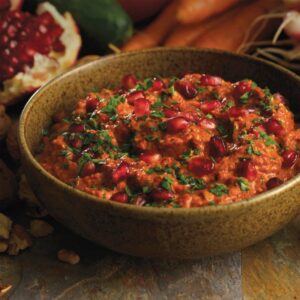
Sauces simmered through the centuries
PHOTOGRAPHY BY PATRICK TREGENZA
Recipes are not always about cooking. They can be maps into ourselves and into history. Many lie dormant in drawers, in books, in clipped pages from magazines, and sometimes in our minds. Stains, notes and wrinkled corners occasionally begin to tell a story.
In a way, our favorite recipes mirror us. They reflect what we long for and wish to share with others, and maybe who we’d like to be. Trying to figure out how far back these pieces of our puzzle go is always a fascinating journey to the past. Centuries ago, did this spoonful taste as good as it does to me now?
Take one of Spain’s most emblematic sauces: romesco. It is also known as red sauce, salsa vermella in Catalan, the language of the region where it’s from.
In its purest classical form, romesco includes almonds, ñora dried peppers, olive oil and garlic. Roasted tomatoes, hazelnuts, sherry vinegar and paprika have joined along the way. The result is a brick red paste that makes everything taste better.
There are multiple iterations of romesco. A thinner version is served with grilled spring onions or calçots in the Catalan city of Tarragona, where it is taken very seriously. There are contests, manifestos and brotherhoods defending its origin and traditions.
Romesco was constructed through the centuries, starting perhaps with the ancient Middle Eastern technique of thickening sauces with almonds or other nuts, and using ingredients roasted gently among embers as the Romans did. These are some of the common bonds that bring us back to its distant, yet very close relative, muhammara.
Muhammara is also a recipe with a welltraveled path and the name also means red sauce, in Arabic. The base is roasted red peppers as well, and in this case, the dried pepper comes from Aleppo. It is thickened with walnuts and held together with olive oil. A very interesting addition is pomegranate molasses, a sweet and sour touch resulting in a bold mix of flavors that sing loudly in unison. And then there is Sikil pak, the Mayan sauce made with roasted tomatoes, habanero peppers and ground pumpkin seeds. Although extremely similar, we are not sure how their history intersects. Or maybe great minds think alike and create with what’s available nearby.
Romesco and muhammara sauces are so versatile they can transform any meal into something special and take us to faraway lands. Both are perfect with seafood and chicken. They work wonders with vegetables, mushrooms and crusty bread. Add a thick layer to any grilled cheese sandwich for a new dimension, cover roasted cauliflower with it or use it as a final touch to an omelet. It is also great on toast with poached eggs.
Either of the sauces can be tossed with pasta. Treat it like its close Mediterranean relative pesto, by combining it with a little pasta cooking water and adding it to the pasta. Dress up hummus or labneh with it for a crudité platter. Both sauces make a wonderful addition to any recipe collection.
Recipes might have changed through the centuries, but their essence has not; we all love a good sauce. It is fascinating to think we can have a big bite of history, right in our kitchen.


About the author
Analuisa Béjar loves exploring flavor routes as the chef at her Sunny Bakery Cafe in Carmel Valley. She is a recent transplant from Mexico City, where she was a food critic, award-winning writer, editor, recipe developer, culinary teacher and organizer of Latin American gastronomy competitions.
- Analuisa Béjarhttps://www.ediblemontereybay.com/author/analuisabejar/
- Analuisa Béjarhttps://www.ediblemontereybay.com/author/analuisabejar/
- Analuisa Béjarhttps://www.ediblemontereybay.com/author/analuisabejar/
- Analuisa Béjarhttps://www.ediblemontereybay.com/author/analuisabejar/


